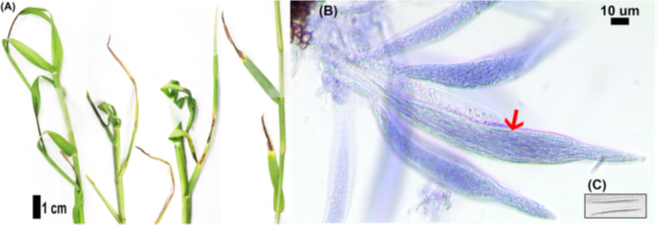
Figure 1. Floralta Limpograss associated with Myriogenospora atramentosa in the field. Tangletop condition caused by M. atramentosa stromata (left) and M. atramentosa stroma on the tip of a leaf (center). M. atramentosa causing a “black line braid” condition by merging multiple leaves along the stem. (right).
–
Ann Blount, Sunny Liao, UF/IFAS North Florida Research and Education Center, Graduate Students: Valerie Mendez, Soil and Water Sciences Department, and Brittany Justesen, Agronomy Department; Livestock and Forages Extension Agent for UF/IFAS Extension Osceola County
–
University of Florida scientists have been collecting and evaluating Florida forages for the presence of fungal inhabitants and mycotoxins for three years. A team of research faculty, graduate students, and extension faculty have collaborated in a state-wide sampling of bahiagrass, bermudagrass, smutgrass and limpograss since 2018. To date, they have collected over 500 forage samples from working Florida ranches.
Since February 2018, the team began sampling pastures on approximately 14 ranch sites strategically located across the state. Florida ranch sites were selected where historically high mycotoxin levels had been found at particular times of the year. The goal of the multi-year survey was to identify the occurrence and prevalence of mycotoxin activity in these four forages species. Additionally, the associated fungi found on the forages were identified through DNA analysis. Sampling has begun for the 2021 season to determine if older growth (advancing age of the forage) often referred to as “standing hay”, “deferred grazing” or “stockpiled forage”, might increase the incidence of fungal and mycotoxin presence.
Several research groups in the U.S. and South America have joined this effort to better understand fungal-plant relationships and what triggers mycotoxin production. Two graduate students, Valerie Mendez and Brittany Justesen, will focus on seasonal changes of fungal inhabitants and mycotoxin levels in suspect pastures. They will continue collaborating with Jennifer Duringer, Oregon State University Department of Environmental and Molecular Toxicology, to identify mycotoxins and levels of these in Florida forages.
To date, the team has confirmed the identification of relevant mycotoxin-producing fungal genera, including Fusarium, Alternaria, and Aspergillus. In several forages multiple mycotoxins occur simultaneously. They have identified and quantified the presence of mycotoxins Zearalenone, ZEAR-4-sulfate Q1, Fumonisin, Beauvericin Enniatin, Ergonovine, Elymoclavine, Lysergol, Dihydrolysergol, Agroclavine, Alternariol and Alternariol methyl ether, as well as other mycotoxins that are potentially deleterious to animal health. Of most concern are levels of zearalenone, an estrogenic metabolite produced by multiple Fusarium species. Data collected for the 2018-2019 season showed significant levels of this mycotoxin and its derivatives in Bermudagrass and Limpograss forage samples that were collected from several ranch pastures.

Figure 2. Limpograss leaves infected by Myriogenospora atramentosa (left). Asci and ascospores of M. atramentosa stained with trypan blue. Red arrow pointing to fusiform asci containing many cylindrical ascospores (right). Fusoid part-spores (bottom right). Credit: Chen K. H, et. al. 2019.
–
A causal relationship between the types and levels of mycotoxins found and animal performance issues that have been observed by livestock producers in the state has not been verified at this point. Animal tolerance levels to the mycotoxins identified have not been widely studied. Few publications confirm that staggers, tremors, respiratory and reproductive issues, including animal death, are related to livestock exposure to mycotoxins. This preliminary research should provide incentive for further study of these “emerging mycotoxins” to define animal tolerance levels and their effect on animal health.
This research will increase our understanding of fungal and mycotoxin presence in Florida forages, DNA profiling of these fungal inhabitants, and mycotoxin type and quantification. The goal is to provide unbiased information about fungal and mycotoxin presence in Florida forages and the possible relation to animal health and performance.
For additional information on this subject, please contact Dr. Ann Blount or Valerie Mendez.
–
Reference:
Chen K. H, Blount, A., Justesen, B., Walter, J., M., Wallau, M. & Liao H. L. (2019). First report of Myriogenospora atramentosa with in the plant genus Hemarthria. Plant Health Progress (Brief) DOI: 10.1094/PHP-07-19-0043-BR.
- Cool-Season Forages – A Pasture Perspective for 2022 - September 16, 2022
- Ornamental Rhizoma Perennial Peanut for Groundcover or Alternative Turf - March 18, 2022
- 2021 Cool-Season Forage Recommendations for Livestock and Wildlife - September 24, 2021
